
An elaborate manhole in Beijing could make you believe that the substantial theft of manholes was motivated by cultural appreciation. That is not the case. It is economic interests that lies in the meager sum you get for the metal they are made out of that tempt so many. Credit and copyright Guanzii.
Manholes, discrete an anonymous as they appear are far more important than what first comes to mind. They are a pivotal part of the infrastructure that drain the water out of urban areas. Such as Beijing.
Dining in Beijing
It wasn't raining when we entered the restaurant. We were a bunch of scientists from the Norwegian Mapping Authority escorted by our Chinese colleagues from The State Bureau of Surveying and Mapping and the Institute of Geographical Sciences and Natural Resources Research. As always when visiting Chinese friends and colleagues we were taken good care of and had a magnificent meal. The Chinese cuisine (in China I have to add) is the best cuisine in the whole wide world. Nobody anywhere take food and eating as serious as the Chinese. The only culture that can be compared to the Chinese in this respect is the French. You don't mess with food or 'La Table' there either. At a Chinese restaurant you spend a good hour only to discuss the menu in depth, around the table, with the waiter, with the cook, with everybody, before ordering. You can imagine the rest of the rituals. But I digress. Well fed and ready for some rest after a hard day's work, a full Chinese table séance and subsequent full stomachs, we left our private dining room. Mentally we were halfway into bed already when we suddenly 'woke up' again. As we stepped out of the restaurant we were stopped by a crowd seeking shelter from a thunderstorm that had moved in over Beijing while we were dining. Mesmerized by the cacophony of sounds coming from water, traffic chaos and thunder we joined the crowd. This was the 2007 Beijing deluge. Finally we managed to snap out of it. Sleep, after all, had a higher priority than the thunderstorm. We could not see exactly where the water went from outside the restaurant, but we discovered it soon enough. As we started to drive back to the hotel we saw that the water transformed the streets into rivers, making it practically impossible to move. It was on this 'river cruise' in Beijing I started to reflect on the many functionalities and importance of manholes. That August evening in 2007 it was already obvious that the capacity of the Beijing drainage system was far from made for this kind of weather. I remember I was wondering how this could be; that a large city like Beijing, the capital of the most populous country in the world, had not built a proper infrastructure for water drainage? I'll come back to the significance of the fact that this story is from back in 2007 and not from this year, the 2012 deluge.
This is a recording of the 2007 Beijing deluge. You'll first see the thunder and lightening outside the restaurant and then some impressions from the streets turned into rivers. (0:56). It got worse!
Urban Planning
Water drainage is an element of urban planning along with water, electricity, telephone, sewer etc. In cities like Beijing this infrastructure is placed underground in intricate networks of tunnels criss-crossing the urban area. Manholes are access points to this infrastructure. In Beijing 2008 you'd find more than 840 000 manholes. Not further back than in 2005 the number of manholes were only around 600 000 which brings me to a major challenge in urban planning. People migrate to cities in masses. Currently more than 50% of the world population lives in cities. Consequently cities are growing so fast that urban planning is made extremely difficult if not impossible. According to World Bank urban planning specialist Pedro Ortiz (see video here from Taiwan where Ortiz uses ancient Chinese planning as an illustration) urban planners have to simultaneously work on three spheres ; economic, social and physical environment where they have to balance particularly economic effectiveness with social justice. Not an easy task, requiring scientific and technological knowledge and capacity as well as political skills and will.
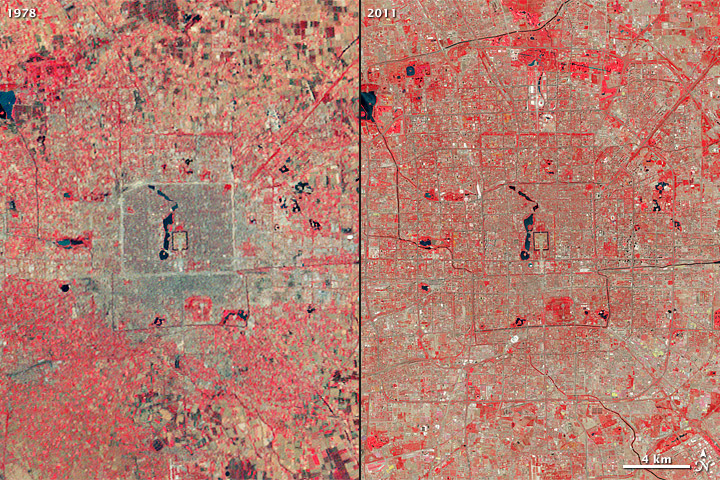
This pair of images shows the growth of Beijing from June 21, 1978, to June 8, 2011. In these false-color images, vegetation is red and bare ground or human development (roads, buildings) are tan to brown. (NASA images by Robert Simmon). A real good look at the explosive growth is better viewed in this video.
The Chinese State Bureau of Surveying and Mapping (SBSM) is among the many authorities that has to deal with this complex explosive growth we sometimes call urban mushrooming. The bureau can not keep up with the pace of construction and the urban development. On top of the pace itself, they also see and have to incorporate in their maps the results of both regulated and non-regulated/informal construction. The use of satellites and remote sensing are the only way to stay abreast and thus these space technologies are becoming more important and perhaps one of the reasons why International Society for Photogrammetry and Remote Sensing (ISPRS) is given high priority by the Chinese. In 2008, at the ISPRS congress in Beijing called “Silk Road of Imagery for Information from Imagery” SBSM's Chen Jun was elected Secretary General of ISPRS. Today he is also engaged in other international organizations building Earth observation capacity such as The Group of Earth Observation. The question now is whether China will be able to combine their ancient knowledge with modern space technology to tackle the urban challenges.
Modern times mapping: Through social media this near real-time map was created during the 2012 Beijing deluge, showing the most dangerous places in the city. Source Chinadaily.com via Xinhua.
Flood control and urban planning in Beijing
Since China is considered the cradle of civilizations, I feel my expectations of China's capacity to build well functioning urban structures are justified. My expectations being implicit in my thoughts during our “sailing” on the streets of Beijing in 2007: Why isn't the water drainage system working in a metropolis like Beijing? Obviously, the Beijing population expect no less than me from their administration. According to Chinese media, the mayor of Beijing had to step down in the wake of the deluge and killer flood. The official number of casualties was updated from 37 to 77 a short week after the incident of the 2012 version of Beijing deluges, and the direct economic losses were calculated to more than 2.2 billion yuan (358 million USD). The event reminded the Beijing population that this was actually a recurring problem each year. As I said, my experience with a Beijing deluge was from 2007. Last year in 2011 again, Beijing had a once every 10 year downpour. Making excuses for an inadequate drainage system based on a once every 60 years event was not accepted by the population this time around.
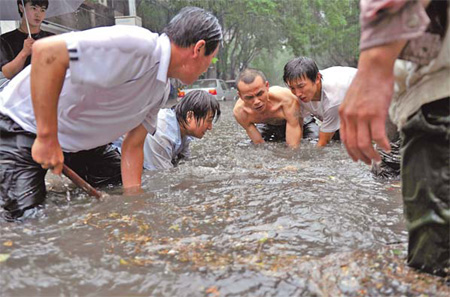
Trying to remove a manhole to make way for the water in Beijing during the 2011 deluge. The Beijing population is not too happy about having to do this kind of work every year. Photo: Jin Shuo/China News Service
Having a Ministry of Water Resources leaves no doubt that Chinese politicians think water management is important. This Ministry is responsible for flood control and drought relief. As a comment to the 2012 deluge, government officials indicated that new regulations concerning drainage system designs are expected to be launched in 2013. Not too soon but very appropriate one could say, 2013 being the International Year of Water!
In Beijing it is the Beijing Municipal Flood Control that is responsible for flood management. The problem today is that the subsurface infrastructure is not built or adapted for the volume of water the region is frequently receiving. Urban constructions stop the water in the wrong places and generally hinder the water to be absorbed by the soil. Cost efficient solutions for water drainage relies on good estimates of the volume of water expected for the region. Another problem, according to the public in Beijing, is that there is little or no warning. All in all, a whole range of scientific fields and technology are necessary to find good solutions. In addition to the political aspects of course.
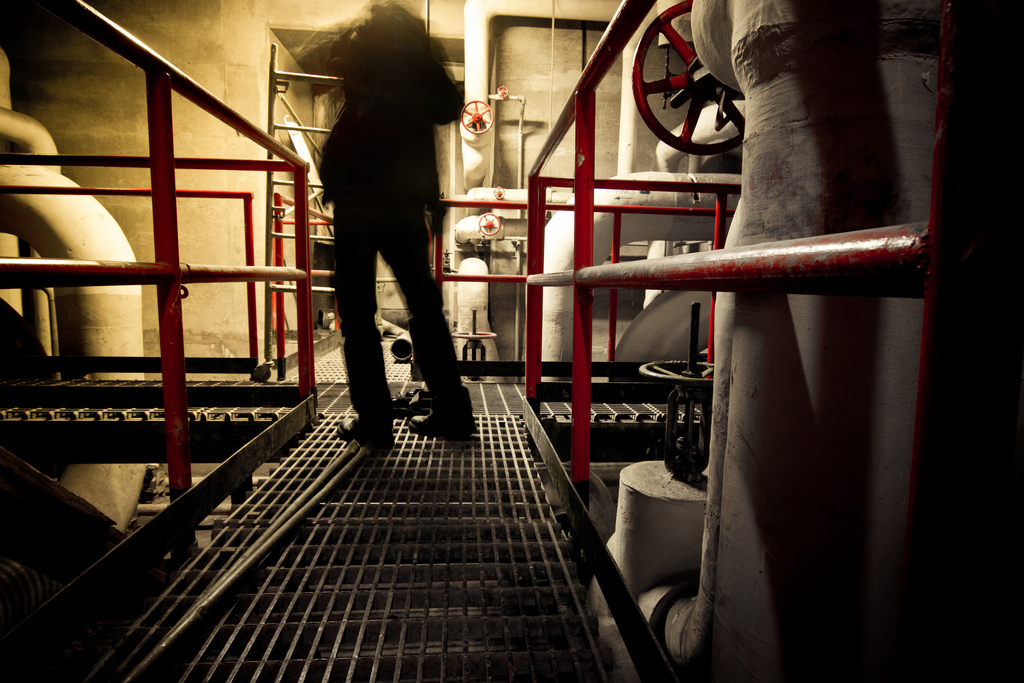
Building a subsurface infrastructure that has the right dimensions and able to adapt to the city's future needs requires a number of different competencies. Photo courtesy of urban explorer Erik M at Section 6.
The plethora of Chinese research institutes is incomprehensible. There are 10s of millions of scientists in China and an ever increasing number of scientists and engineers are educated every year. The politicians are highly educated as well, so one could expect also for that reason that they would be able to absorb and make use of science and technology in operational and administrative functions such as flood control and urban planning. Nevertheless, the Chinese struggle with the same challenges as the rest of the world. In this particular case: How do you integrate modern space technology and scientific knowledge when continuously building and managing an explosive urbanization?
The most successful transfer from science to operational services is between meteorology and weather services. It goes without saying that meteorological information is pivotal, both for planning of the water drainage capacity and for early warning and risk management. My humble 5 cents to the Beijing municipality would be to check out FENGYUNCast. There they can find data from the FY satellite family and then some! In addition to seek advise in their own specialized research institutes such as China Institute of Water Resources and Hydropower Research, Beijing will surely benefit from participating in international research programs such as the ESA-MOST Dragon program. It may very well be that the Beijing municipality already knows of these organizations and programs, but at least it seems to be a good thing to encourage better integration and cooperation...

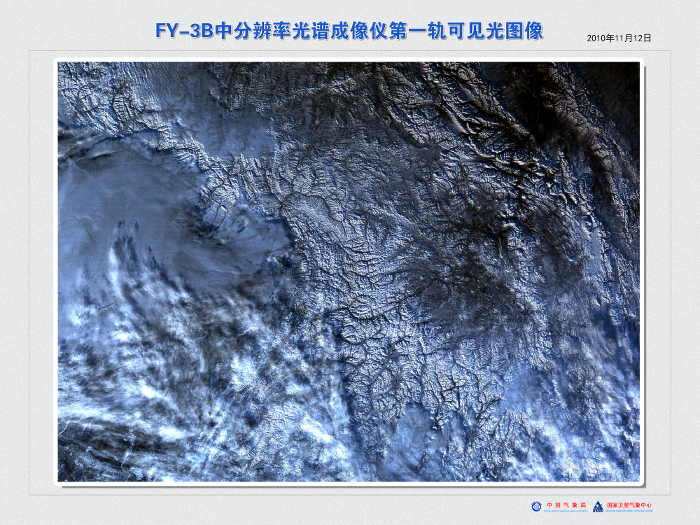
China has a suite of satellites called FENGYUN. Inspired by cooperation through the Group of Earth Observation, data from these satellites are available via a portal called FENGYUNCast. (Feng=wind, Yun=cloud).
Space and urban exploration
Urban planning of a metropolis, or any kind of city for that matter, that goes through and explosive growth, demands both a bird's and a rat's perspective not to forget the regular 2-dimensional surface view. The bird's perspective is made possible after years of space exploration resulting in a wealth of satellite technologies. Urban exploration includes development of the cities underground infrastructure. It is a fascinating place to visit, if you do not mind encountering the occasional rat. Some visits are formally organized such as in London or the unique Beijing Underground City. While others of the informal kind requires unauthorized use of manholes. I am not encouraging people to do that, but I must admit I very much enjoy watching the recordings from such perhaps questionable visits underground.
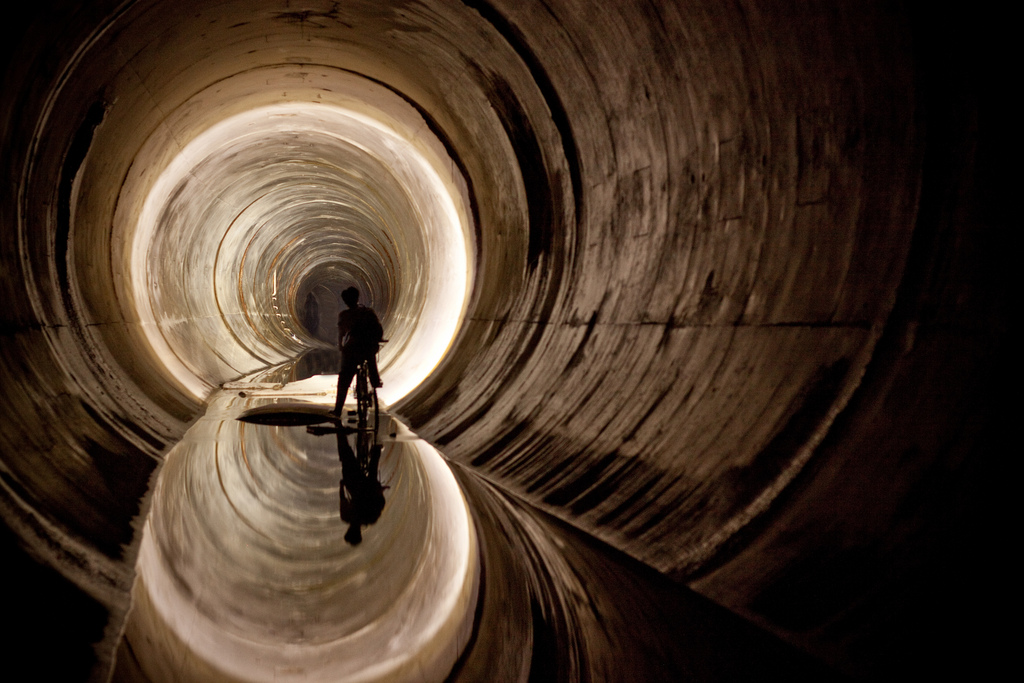
Urban exploration can be both exciting and beautiful, believe it or not. Photo courtesy of urban explorer Erik M. at Section 6.
It is hard to say what the future will bring, but I am pretty confident that we will find many a new manhole in Beijing in the years to come. Let us hope these manholes will lead to larger tunnels than today, guiding the water safely away in subsurface rivers.


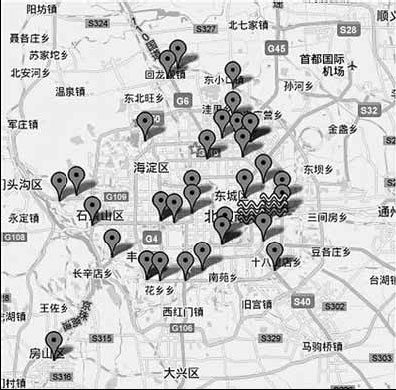


Comments